Saturday, 22 August, marks the 30th anniversary of the Nurses Amendment Act 1990, providing statutory recognition for midwives as “safe and competent practitioners in their own right.” In addition, midwives won the statutory right to prescribe drugs, order and interpret diagnostic tests, and train without prior nursing qualifications.
Nevertheless, for the next 30 years DHB-employed midwives continued to be paid on the same pay scales as nurses. That changed on 1 August when all MERAS members received a pay increase taking the top of the core midwives scale to $78,353 a year, and midwifery graduates who are MERAS members will start on step 2 of the pay scale on $59,222 a year.
To symbolise this break from the nurses’-led pay scales, MERAS will be giving every member a pair of scissors.
However, there is more work to do. Although midwives practice autonomously, in much the same way as doctors, we are arguing through the Midwifery Pay Equity process that midwives are undervalued partly because the midwifery model of practice is based on ‘inherent or natural abilities’ of women that are not accounted for in their pay.
We are also pointing to the method of wage fixing by the DHBs that has tied midwives pay into that of nurses, another women-dominated profession that suffers from gender-based undervaluation.
To read the full version of this article see the latest MERAS Update
